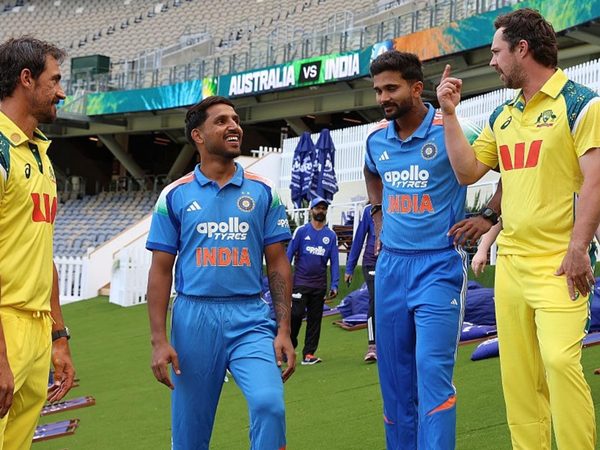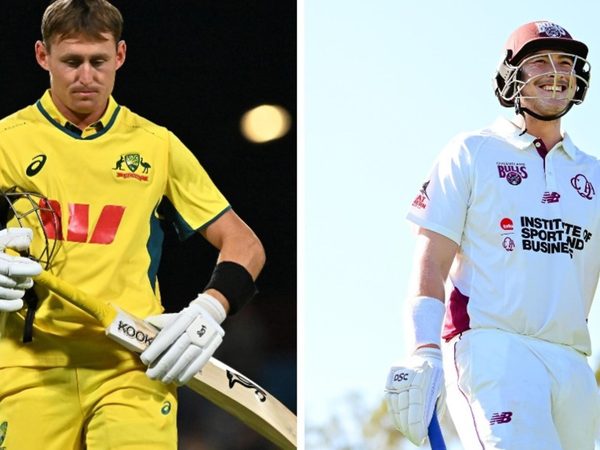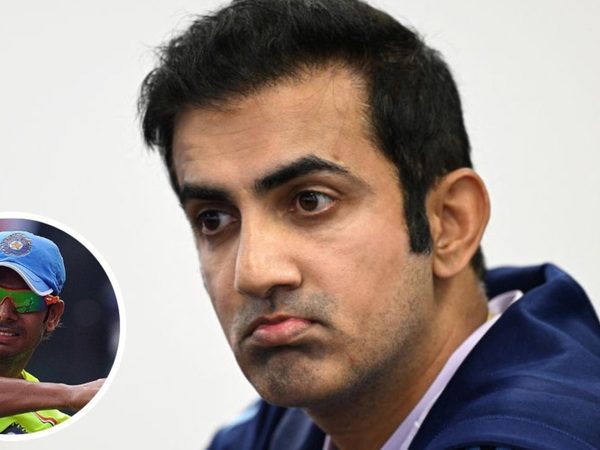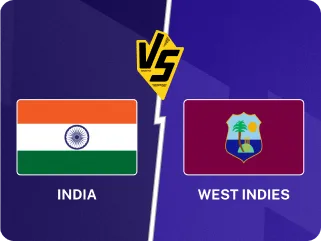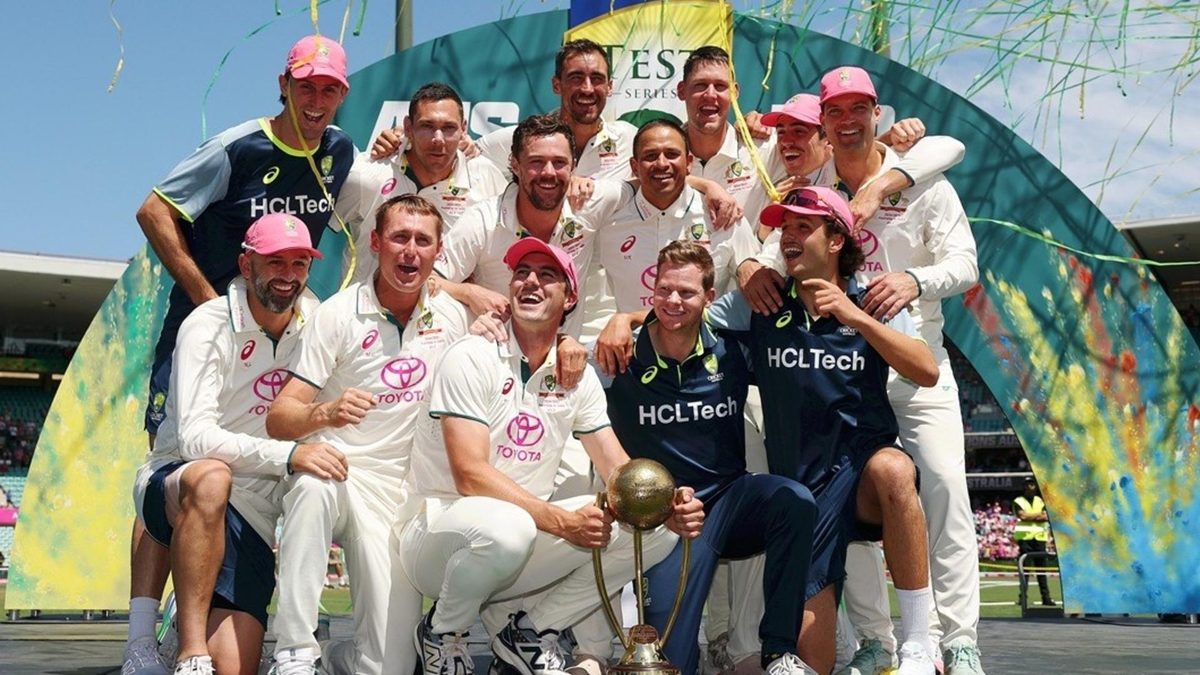
India toured Australia in 2024/25 for five Test matches and lost the series 1-4. Gideon Haigh’s tour report as well as all five match reports appeared in the 2025 edition of Wisden Cricketer’s Almanack.
Australia v India in 2024/25
Test matches (5): Australia 3 (40pts), India 1 (16pts)
On the last morning of this epic Test series, India still had a chance of retaining the Border–Gavaskar Trophy, and Australia were not assured of a place in the World Test Championship final. In the event, the home team prevailed 3-1, their task greatly eased by the absence with back spasms of Jasprit Bumrah, the summer’s greatest single influence on either side, with 32 wickets at 13. But it was indicative of the tightness of the competition, with Australia winning a home series from 1-0 down for the first time since 1968/69, when Garry Sobers was captaining West Indies.
Ultimately, justice was done. Having surrendered the trophy in 2016/17, then lost twice to India at home, Australia were this time better prepared, better selected, better coached and better led. The series was a triumph above all for Pat Cummins, who averaged 21 with the ball and 20 with the bat, seldom missed a trick in the field, and totally eclipsed his rival Rohit Sharma, dismissing him four times for 11 runs. Rohit arrived late, having missed the first Test for the birth of his second child, and left early, supposedly resting himself from the fifth Test.
His decline formed part of a trend. Extra grass and a twice-lacquered Kookaburra envenomed pace bowlers on both sides, making for the lowest-scoring Test series in Australia in nearly 30 years. There were only 14 partnerships of more than 50 for the first five wickets, partly compensated for by the record number of balls – 3,191 – soaked up by wickets six to ten. Spin played virtually no part, despite two Tests lasting the full five days. Ravichandran Ashwin perhaps saw the writing on the wall when, after the third at Brisbane, he announced his retirement, effective immediately. Nathan Lyon’s greatest contribution was the 60 he added with Scott Boland for the last wicket in Australia’s second innings at Melbourne.
It is misleading to call Bumrah a revelation, as he was a known quantity, but he attained heights of mastery that made it seem like there were two series in progress: one where we watched him bowling, the other where we waited for him to bowl. In the first series, for instance, Usman Khawaja averaged five; in the second, 50. Bumrah reduced one nervous debutant, Nathan McSweeney, to a sitting target; it was a source of widespread astonishment when a second debutant, teenager Sam Konstas, came out in the Melbourne Test and ramped Bumrah serially through the most expensive spell of his career. Bumrah delivered 28 per cent of India’s overs, taking 40 per cent of their wickets, at a third of the cost of the other bowlers.
Cummins was reinforced by the remarkable Boland, who joined the ranks only when Josh Hazlewood was injured, and in three Tests further reduced his bowling average on home soil to 12. Tireless and accurate, he was chiefly responsible for the struggles of Virat Kohli, who made a second-innings hundred in Perth, only to slip away abjectly: Boland dismissed him four times in the series at an average of seven. Deprived of impact with the bat, Kohli could make impact only with his shoulder, brushing arrogantly against Konstas as they passed in mid-pitch in Melbourne – the pettiest act of a great career, and for which the ineffectual ICC imposed only a token fine. Nothing became Kohli so little as the manner of his departure from Australia.
Coming after India’s failures against New Zealand at home, their performance at Perth Stadium was a shock to the system. Yashasvi Jaiswal and KL Rahul denied Australia a wicket for two entire sessions; Australia’s bowlers, wrapped in cotton wool for months, seemed underdone. The false dawn lasted as long as it took Mitchell Starc, armed with the pink ball, to dismiss Jaiswal with his first delivery at Adelaide Oval. “We’ve spent a lot of time together as a group over the years, so we knew we weren’t at our best at Perth, but it was never as bad as it seems,” said Cummins. “So you stick tight and double down on what makes us a really good side.” One of those things was Travis Head, whose capacity to stay leg side of the ball, freeing his arms to play through the off, made him difficult to stop once set: he made 415 runs in four innings, 33 in six others.
Two further hundreds, his first since Lord’s in 2023, also accrued to Steve Smith, who finished the series a single short of 10,000 Test runs. His 101 at Brisbane was a careworn effort with three boundaries, his 140 at Melbourne a celebration of future potential. It was his 11th hundred against India, to go with 12 in the Ashes.
India’s selection, meanwhile, seemed confused. They conservatively lengthened their batting, slotting in the promising Nitish Kumar Reddy at No.8 when he should have been higher, and excluding Ashwin to fit in Washington Sundar, a superior batter. Reddy and Sundar had a good partnership at Melbourne, but the strain that caught up with Bumrah was an indication of India’s over-dependence on him.
Fans were almost as much the stars as players. The aggregate of 837,879 was the fourth-highest in Australian history. Melbourne’s attendance of 373,691 was a record for any Test in Australia, surpassing the 350,534 who watched Don Bradman’s side defeat England over six days in 1936/37. The final-day attendance of 74,362 was a record fifth-day crowd for a Test in Australia. Non-Ashes attendance records were broken at every venue. Ratings were the highest since Channel Seven and Fox Sports acquired the broadcast rights in 2018, and video engagements were unprecedented. It’s little wonder that soon afterwards were bruited ICC plans to split Test cricket into two divisions, mainly to enable Australia and India to meet more often: in the great economic Test match, self-interest wins by an innings every time.
India’s touring party to Australia, 2024/25
*RG Sharma, R Ashwin, JJ Bumrah, A Deep, AR Easwaran, S Gill, YB Jaiswal, RA Jadeja, DC Jurel, SN Khan, V Kohli, TK Kotian, PM Krishna, DS Padikkal, RR Pant, KL Rahul, H Rana, NK Reddy, M Siraj, MS Washington Sundar. Coach: G Gambhir.
Padikkal was called up from the A-team after Gill broke his thumb. Ashwin announced his retirement after the third Test; he was replaced by Kotian.
First Test at Perth, November 22-25, 2024
India won by 295 runs. India 12pts. Toss: India. Test debuts: NA McSweeney; NK Reddy, H Rana.
Jasprit Bumrah, captaining while Rohit Sharma finished his paternity leave, turned this game on its head in half an hour after tea on the first day: a spell of 6–2–9–3 led to match figures of 8-72. India, who left out Ravichandran Ashwin and Ravindra Jadeja, included two new caps, Nitish Kumar Reddy and Harshit Rana, in a team with an average age of 26. Australia, whose squad had an average age six years older, despite the introduction of 22-year-old Nathan McSweeney, looked disconcertingly underprepared.
At first, India’s batting did not settle against Australia’s four seamers, who were encouraged by excellent bounce and carry. Only Rahul, who defended coolly for almost two hours, then Pant and Reddy, who ground out 48 for the seventh wicket, showed the necessary application as India were dismissed for 150. But then came Bumrah: his ninth ball trapped McSweeney, hopelessly late stabbing down; his 11th claimed a regulation edge from Labuschagne, but was dropped by Kohli at slip; his 21st and 22nd had Khawaja caught at the wicket, and Smith pinned against his stumps; only an inside edge saved Head from becoming a hat-trick statistic. Soon Head became Rana’s first Test victim, while Siraj trapped Labuschagne on the crease after 95 minutes of strokeless defiance. By the close of a first day on which 17 wickets went down, Australia trailed by 83 with just the tail remaining. The innings was prolonged to lunch only by 112 balls of studious defence from Starc.
After 20 wickets in four sessions, none fell in two. Rahul, defending late and leaving well, played expertly, while Jaiswal, after an early struggle, began to show the talent that had made him India’s outstanding batter of 2024. His first fifty took a steady 123 balls; the second 82, accelerated by three sixes; the third 70. His eventual 161, his fourth Test century, spanned seven hours 12 minutes, and set the ideal platform for Kohli’s 33rd, after two barren years. Given so little respite, the Australian attack were well and truly subdued and, once the second new ball was seen off, posed little danger. Lyon bowled with his usual patience, but Marsh was lethargic, and the part-time varieties of Labuschagne and Head were deployed mainly to spare the frontline bowlers pointless punishment. A noisy contingent of Indian fans, equipped with drums and flags, enjoyed every minute.
Kohli, who had nicked off tentatively on the first morning, was now decisive and purposeful, an early on-drive off Cummins executed with refreshed authority, a slash for six off Starc knocking a security guard senseless – he was looking in the opposite direction in the roped-off area at third man. To expedite a declaration after tea on the third day, Kohli added 60 in 71 balls, partnered first by Washington Sundar, then by Reddy, who looked more a batter who bowls than a genuine all-rounder; he had three fours and two sixes in his 38 not out from 27. Bumrah called off the seventh-wicket partnership at 77 when Kohli reached his century with a peachy sweep for four. It left time for about five overs – enough for Bumrah to strike twice, while Siraj cut Cummins’s nightwatchman duties short. McSweeney was fatally late on a ball that kept a touch low, and Labuschagne humiliatingly struck in front without offering a stroke. He reviewed the decision, mainly to ensure there was time for no more play, and no more Bumrah. Such by now was the negativity of Australia’s thinking, still 521 in arrears.
After Khawaja top-edged a cramped hook at the next morning’s seventh ball, Head provided the best Australian resistance of the match, peeling off eight boundaries in making 89 after a quiet year in red-ball cricket. Siraj ended Smith’s painstaking hour and a half in the middle, before Head and Marsh, both returning from paternity leave, extended their partnership to a sparkling 82 from 87 deliveries. But the sting had left the match. Once he returned to have Head caught behind, Bumrah left the heavy lifting to others. Reddy made Marsh a first Test wicket; Sundar dismissed Starc and Lyon in the same over, interrupted by tea; Rana bowled Carey to finish the game, and put India on top of the World Test Championship table. Bumrah took the individual award, but heralded it as a victory for trust in youth: “Experience does matter, but faith helps do something special.”
Player of the match: JJ Bumrah. Attendance: 96,463.
Second Test at Adelaide (day/night), December 6-8, 2024
Australia won by 10 wickets. Australia 12pts. Toss: India.
Having arrived in Adelaide amid dire forebodings, Australia maintained their astonishing success in pink-ball cricket by winning a 12th floodlit Test out of 13, in little more than two days – both drawing crowds above 50,000. They had eyes for one man only, local boy Travis Head, and he did not let them down, clattering 140 in 141 balls in a match that contained only one other half-century. Australia were without Josh Hazlewood, who had a calf injury, but they did not miss him thanks to Boland’s disciplined line; Lyon bowled just a single over. The Test lasted only 1,031 deliveries – the shortest between these rivals for a match with a definite result.
Back with his squad, Rohit Sharma had chosen to bat – a successful policy in pink-ball cricket that showed its limitations in overcast conditions on a pitch shaggy with grass. After his heroics in Perth, Jaiswal was torpedoed by Starc’s yorker from the first ball of the match, and India lost four for 18 in 43 deliveries either side of the first break, including their captain, heavy-booted, and Kohli, throwing his hands at a ball on fifth stump in what would become familiar fashion. Starc came back, fast and full, to quell a spasm of resistance led by the impressive Reddy, bequeathing Australia’s openers a dangerous 33 overs under lights before the close. In the event, India bowled over-eagerly short, and McSweeney in his second Test defended manfully to see his side to the close for the loss of only Khawaja. There was a bizarre interlude when the lights were twice briefly extinguished – the outcome of an attempt to turn on the lights in the indoor nets, where Lyon had requested some batting practice.
Bumrah struck twice early on the second afternoon but, as he tired and the ball softened, Labuschagne laid the groundwork for Head’s decisive innings – his third hundred in Tests under lights, and his fastest of all, at 111 balls, complementing his centuries against India in the finals of the World Test Championship and 50-over World Cup. Adelaide fans often desert their terraces in favour of the enticements of the hospitality marquees on the lawn, but not this day – they cheered every boundary of Australia’s romping five-an-over progress. Head hit three sixes off Ashwin, who it turned out was playing his final Test, including a blow that carried 110 metres over the sightscreen; he took Siraj, armed with the second new ball, for a fourth over square leg. When Siraj slipped the next delivery beneath Head’s bat, he followed up with a gratuitous send-off, for which he was fined a fifth of his match fee, and Head retorted saltily, for which he was reprimanded. Each incurred a demerit point. Siraj became a target of Australian booing for the rest of the summer.
India claimed the last five for 55, but by now the damage was done, and Australia’s pace bowlers were more effective than their opponents’ had been in the evening session. Cummins unsettled Rahul with a lifter, Boland removed Jaiswal and drew an anxious thrust from Kohli, while Starc removed Gill’s middle stump with a hooping yorker. Rohit’s stay was particularly painful: Starc hit his helmet first ball and bowled him with the second, but he had overstepped; just before the close, Cummins toppled his off stump with a delivery that seamed away. Pant played some exotic shots, including a fall-over scoop for six, but succumbed quickly next day, and only some forthright stokes from Reddy, who twice top-scored with 42 from No.7, guaranteed Australia would bat again. Just 20 balls were necessary to knock off the 19 runs required.
Cummins, who secured his 13th Test five-for, pronounced himself well satisfied: “This week we were back to our best – the team I remember – and how we want to play our cricket.” Rohit defended his choice at the toss: “When you come to Australia, the best chance of winning a Test match is by putting runs on the board.”
Player of the match: TM Head. Attendance: 135,012.
Third Test at Brisbane, December 14-18, 2024
Drawn. Australia 4pts, India 4pts. Toss: India.
Brisbane’s inconstant weather had the last word in this sometimes exciting, often frustrating Test, stalled 17 times by rain or bad light, meaning the last day began with the game’s second innings still in progress, and ended with the fourth having just begun. The series remained tied up at 1-1, but with Australia in the ascendant.
After being sent in, they dominated much of the proceedings, their openers surviving the 13.2 overs to which the first day was restricted, their batters eventually exceeding 400 for the first time in a year. After his own lengthy hiatus, Smith registered his tenth hundred
against India, to go with 12 against England – the first player to reach double figures against both. He had resumed his back-and-across trigger movement, and attained something like his old self-containment, biding his time through a first fifty in 128 balls, achieving great fluency during a second in 57. Again, though, Smith was somewhat overshadowed by the mercurial Head, who contributed 148 of their 241-run fourth-wicket stand. Rohit tried to defend, but this still left gaps into which Head worked the ball – he had 53 singles to go with 18 fours. Bumrah eventually dismissed both, and Marsh, in 11 balls, but when he was not bowling, India seemed close to disintegrating. Carey prolonged their agony, last out for 70.
Australia’s pace bowlers then made short work of India’s top order, who were grateful for rain after Starc removed Jaiswal with his second ball, and Gill chased a wide one. Rahul alone had the technique to survive, though his fourth-day task was made easier when Hazlewood injured a calf in the warm-ups and retired from the attack after a single pained over. Rahul had made 84 out of India’s 141 when he was brilliantly caught off Lyon at slip by Smith, who had earlier dropped him from the day’s first ball on 33 – a far easier chance. Jadeja, who had been included for Ravichandran Ashwin, prolonged the resistance through the fourth afternoon with a patient 77 but, when he mishooked Cummins to the diving Marsh at deep backward square, India were still in danger of following on. Their salvation was provided, improbably, by Bumrah and Deep, who celebrated squeezing past 245 by hitting Cummins for an enormous six, amid scenes of wild enthusiasm in the Indian dressing-room. Their partnership of 47 in an hour was ended early on the final morning by Carey’s stumping, to go with his four catches.
Australia’s second innings was a curious affair, neither obviously aggressive nor defensive after Bumrah struck twice in his opening spell. Showers kept interfering with Cummins’s calculations, and he called a halt after 18 rather ragged overs, though there was then time for only 13 deliveries of India’s chase of 275 in 54 overs before inky clouds disgorged their contents for the rest of the day. The aftermath was overshadowed by Ashwin’s appearance at his captain’s press conference, where he made a prepared statement announcing his retirement, and his departure for India next day. Head won the individual award for the second consecutive Test, though Bumrah might have for his 9-94.
Player of the match: TM Head. Attendance: 87,689.
Fourth Test at Perth, December 26-30, 2024
Australia won by 184 runs. Australia 12pts. Toss: Australia. Test debut: SJ Konstas
One of the most extraordinary Tests of modern times concluded at 5.23 on the final day, having lasted 405 overs, entertained a record crowd of 373,691, and attracted record ratings for free-to-air Channel Seven and subscriber Fox Sports. The cricket fully measured up: sterling centuries from Smith, his 34th in Tests, and Reddy, his first, repelled incisive bowling from Boland and Bumrah, who took nine more wickets. But the match award was fully earned by Cummins, whose 6-117, innings of 49 and 41, and shrewd generalship may have been his outstanding Test performance.
His first success had come at the toss, setting the scene for an astonishing debut by 19-year-old Sam Konstas, who had replaced Nathan McSweeney in a team which – uniquely for Australia – now contained no one in their twenties. Beaten by Bumrah four times in the first over, Konstas elected to ramp his 11th delivery. After failing at his first two attempts, he scooped three times in five balls, for four, six and four. He then gave himself room to carve through the off side and over mid-on, breezing to 45 in 44 balls. The Indians looked flabbergasted, Kohli furious – so furious that, as they passed between overs, he brushed shoulders with Konstas, accidentally on purpose (and then blamed Konstas). The ICC having unaccountably downgraded physical contact as an offence, match referee Andy Pycroft registered this as a Level 1 Code of Conduct violation, setting a regrettable precedent by fining Kohli a token fifth of his match fee.
Konstas’s freedom, and the more orthodox methods of Khawaja and Labuschagne, deferred Smith’s entrance until the 45th over, just as conditions were easing. He took full advantage, batting almost breezily in his first fifty. Bumrah returned for a third incisive spell (6-2-15-3), but Australia outlasted him and lost only one further wicket for the day, before Smith and Cummins extended their partnership to 112 next morning. When Smith reached his century, he took the game on, particularly to the flagging Siraj, and Australia were not bowled out until ten overs after lunch. It was the first time since June 2023 that had they passed 400 in consecutive first innings.
India began their reply positively, with Jaiswal playing a crisp and decisive innings, and Kohli settling in beside him, his entrance having been accompanied by a storm of cheers from Indian fans, and boos from Australians irked about his apparent impunity. With the close in sight, however, Kohli sent Jaiswal back as he hared off for a single to mid-on, and he was run out. Kohli then fenced on a line where he had previously been leaving, and the nightwatchman Deep was caught round the corner for good measure: 153-2 had become 159-5.
Australia continued their steady inroads on the third day, helped by a bizarre attempted scoop by Pant which ended up caught on the third-man fence. They struck a solid line of resistance in Reddy and Washington Sundar, whose eighth-wicket partnership of 127 in 47 overs was the match’s highest, and arguably best: chanceless, disciplined, resilient while the follow-on was in play, then refreshing afterwards. The 21-year-old Reddy, with a solitary hundred from a score of first-class matches before this tour, continued his advance, looking a top-six batter in the making; Sundar, playing his first away Test in four years, presented his credentials as Ravichandran Ashwin’s successor. They were not separated until Smith took a smart slip catch off Lyon to remove Sundar, whereupon Reddy threw the bat to make sure of his century, watched in the crowd by his emotional family. His father’s ecstasy was captured by TV as the son drove Boland back over his head for four.
Bumrah kept Australia on a tight leash through the fourth day, as the ball continued to seam and the bounce grew less predictable. Labuschagne was beaten ceaselessly in the afternoon, but survived to make a second invaluable seventy, and Cummins a second invaluable forty in building the lead. That said, Australia were only 278 to the good when their captain was ninth to fall. A dogged 20-over partnership of 61 between Lyon and Boland provided a helpful buffer, leaving India with really only a draw to play for – and of this they seemed temperamentally incapable.
The last day will never be forgotten, least of all by the Melbourne Cricket Club. Tickets were $10, with proceeds to charity. A single bay was set aside for potential takers. But as word spread, the queues lengthened, and one bay after another had to be staffed and opened, until the entire ground was almost full. By noon, the Australian crowd record had been broken; in the end, the 350,534 of 1936/37 was comfortably beaten.
By then India were 33-3, with Rohit and Kohli gone, but Jaiswal and Pant kept the bowlers out, to the point where the over-rate became a cause of concern to Cummins, who threw the ball to Head, to speed things up with his off-breaks. Unable to help himself, Pant hit the fourth ball of his second over to long-on, where Marsh judged the catch well. Boland returned to remove Jadeja, Lyon shut down Reddy, and Cummins took the crucial wicket of Jaiswal, who played a hare-brained hook. Nothing showed up on Snicko, but third umpire Sharfuddoula overturned Joel Wilson’s on-field not-out decision, and the replay left little doubt that bat and glove had been involved, despite Jaiswal’s protestations, and a tart tweet of criticism from BCCI vice-president Rajeev Shukla. Boland swooped to remove Deep and Bumrah, and when Lyon trapped Siraj second ball the Australian celebrations were wholehearted and joyous. India’s collapse of seven for 34 had been witnessed by a crowd confirmed in the afternoon as 74,362.
“It’s probably the best Test match I’ve been involved in,” said Cummins. ‘It felt like it swung a lot – we never felt like we were so far ahead of the game that it looked certain.” Rohit fended off questions about the workload of Bumrah, who had never bowled more overs in a Test: “He has bowled a lot – but every Test we play, we keep that in mind. But if somebody is in such a great form, you want to try and maximise that however you can.” Rumours swirled that India’s coach Gautam Gambhir had excoriated his players after the defeat, and that Rohit himself would resign.
Player of the match: PJ Cummins. Attendance: 373,691.
Fifth Test at Sydney, January 3-5, 2025
Australia won by six wickets. Australia 12pts. Toss: India. Test debut: BJ Webster.
After the five-day epics of Brisbane and Melbourne, the Sydney Test was sharp and conclusive – at 1,141 balls, the third-shortest completed at the SCG, behind two in the 19th century. The decisive moment, at two on the second day, came when Bumrah left the ground in the grip of back spasms that confined him to ten overs. He had been captaining India after Rohit Sharma’s decision to “rest” from the game, in view of his poor batting form; afterwards, although Gill was nominally vice-captain, India were led by Kohli, prowling and gesticulating to no avail as they surrendered the Border–Gavaskar Trophy he had won as captain in 2016/17. For Australia, 31-year-old all-rounder Beau Webster, from Snug in Tasmania, replaced Mitchell Marsh, and seized his opportunity with both hands, top-scoring with a composed 105-ball 57 in the first innings, and hitting the winning runs in the second. At 35, Boland had another astonishing match, taking his first ten-wicket haul in 121 first-class games.
Bumrah won the toss and batted, despite the pitch presenting an unusual sight – a mat of lush grass. It offered good if not untoward bounce throughout, which suited Boland’s accuracy. He had Jaiswal caught at third slip, and next ball seemed to have Kohli caught when a diving Smith at slip knocked the ball up to Labuschagne in the gully, but third umpire Joel Wilson ruled that it might have made contact with the grass. After Gill had wandered down the track to the last ball before lunch to make a gift of his wicket, Kohli offered an unambiguous catch to the towering Webster at third slip. Pant battled the conditions and his instincts in an innings of two and half hours, hit all over the body until he smacked a wide, short ball straight up in the air; Jadeja stuck it out just as long to less effect.
It left Australia three overs to face, and they proved eventful. As Khawaja temporised, Bumrah visibly fumed and Konstas audibly interjected, insisting his partner was not ready. When bowler and non-striker walked towards each other, the umpires stepped in. And when Khawaja nicked off next ball, the Indians celebrated unrestrainedly, with Konstas their clear focus – an exchange about which both coaches had their say. Andrew McDonald spoke of having a “duty of care” to Konstas, and the possible impact of having “an opposition swarm the non-striker”. Gambhir sounded more like an Australia archetype: “Look, it’s a tough sport played by tough men. You can’t be that soft. That’s as simple as it can get. I don’t think there was anything intimidating about it.”
Australia found the surface challenging as well, with Siraj, fighting back, and Prasidh Krishna, who had replaced the injured Akash Deep, enjoying the encouragement. No force on earth seemed capable of preventing Smith reaching 10,000 Test runs, but Krishna had him held in the cordon at 9,995, then bowled Carey through the gate and had Webster adeptly caught in the gully. Reddy pitched in to remove Cummins and Starc, and the hosts unexpectedly trailed by a boundary. Jaiswal hit four fours in Starc’s first over, and with Rahul in tow zoomed through the next six. Then, again, came Boland. He bowled both openers and had Kohli caught at slip again inside three overs, while Gill presented Webster with a maiden Test wicket by edging behind.
Pant loosened Australia’s grip with a riotous 29-ball half-century, taking 22 from eight balls from Webster, and hitting Starc for consecutive sixes into the crowd at square leg. But Cummins returned to get rid of Pant and Jadeja, and caught Reddy at mid-off. Diving in front of Khawaja, Smith dropped Washington Sundar before the close, but all thoughts were now of Bumrah, who had spent three hours away from the ground as scans revealed the damage in his back. When he could only gingerly roll his arm over during the following morning’s warm-ups, Australian confidence soared. And after Cummins and Boland closed out the Indian innings in 40 clinical minutes to limit the target to 162, India’s bowling opened chaotically: after three overs, Australia were 35 for none, helped by a dozen extras. With four fielders on the fence, Konstas hit Krishna straight up in the air, then Labuschagne and Smith – having moved to 9,999 – both played strokes betraying their anxiety about the pitch. But the 38-year-old Khawaja, in perhaps his last Test on his home ground, batted calmly for an hour and a half, and Webster and Head finished the match with a positive partnership of 58. At a run a ball, it was the fastest chase of a fourth-innings target of 150 or more in the SCG’s long history. It left the Border-Gavaskar Trophy in Australia’s hands for the first time in eight years, and ensured them a place in the final of the World Test Championship in June.
Player of the match: SM Boland. Attendance: 141,518.
Player of the series: JJ Bumrah.

